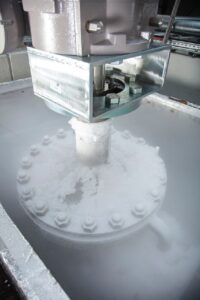Gas detector: fugitive emissions of hydrogen are imperceptible for human beings
With the latest United Nations scientific report causing shockwaves around the world, there is increasing urgency to expand renewable energy sources and to embrace new energy carriers. The most promising and currently undisputed energy carriers of the future include hydrogen. This article considers the role high-quality butterfly valves can play in the energy system transformation and what particular challenges hydrogen places on industrial valves.
By Patrick Hofacker and Michael Knorr, Müller Quadax
The evolving hydrogen industry
The evolving hydrogen industry today, hydrogen (H2) is primarily used for the production of nitrogen fertilisers or while cracking hydrocarbons in oil refineries. Hydrogen plays an equally important role in the production of syn-thetic fuels. Gas, coal or biomass are used for this as primary energy. In the future, hydrogen-aliment-ed fuel cells as an environmentally friendly energy converter will become more and more important in electric mobility. Moreover, hydrogen will prevail as a future energy carrier for transport vehicles.
As the world looks towards decarbonisation of the energy sector, hydrogen – and especially ‘green hydrogen’ produced without emitting any carbon di-oxide (CO2) – will come increasingly to the fore as an energy carrier. For example, water electrolysis is al-ready proven in pilot projects and now so advanced that “CO2-neutral hydrogen” can be produced from entirely renewable energy in large quantities. However, in order to balance an increasing production capacity with fluctuating demand, enormous hydrogen storage facilities will become necessary. For this purpose, gaseous hydrogen is cooled down to minus 253 °C, condensed in liquid form and kept in liquid gas stores.
The valve challenge

In order to assess which check and control valves are suitable for application with hydrogen, certaincriteria have to be observed. That is because due to its chemical and physical properties, the han-dling of hydrogen differs substantially from other energy carriers such as liquid gas (LPG) or liquid natural gas (LNG):
• Hydrogen is colourless, odourless and tasteless, and depending on the relevant concentration, can be flammable or even explosive in ambient air. Note also that gaseous hydrogen cannot be perceived with human senses.
• The enthalpy of combustion, namely the measure of energy in the thermodynamic process, is lower with hydrogen in comparison with many hydrocarbons. Put another way, hydrogen has a lower volume-related energy density than natural gas. So to store the same amount of energy, a hydrogen tank needs to be three times as large as a natural gas tank. Or the hydrogen has to be stored at three times the pressure.
• The density of gaseous hydrogen is merely 0.09 kg/m3 making it the element with the lowest density. Consequently, hydrogen diffuses relatively easily through a variety of materials. High temperatures and high operating pres-sures reinforce the danger of diffusion. Steels with a high carbon content are therefore not suitable for this medium, because hydrogen causes the material to become brittle, with the components thereby losing their strength.
• Liquefaction of hydrogen at atmospheric pressure requires a temperature of minus 253 °C as opposed to LNG with ‘only’ minus 162 °C. Liquid hydrogen weighs only 0.071 kg per litre. For clarification: liquified natural gas (LNG) weighs approximately 0.41 kg to 0.5 kg per litre and is thus 5.8 times to 7 times denser than hydrogen.
So challenges for manufacturers of tanks and valves includes using sustainable materials that are compatible with hydrogen and also adapting sealing systems given hydrogen’s propensity to diffuse.
This is not an easy task considering that there is a temperature fluctuation of more than 300 °C between the liquid state when storing hydrogen in cryogenic conditions of minus 253 °C up to a transport or gaseous distribution temperature of up to +50 °C.
The valve solution
As a valve manufacturer with wide experience of demanding applications, Quadax® has naturally focussed much attention on the topic of hydrogen. Key challenges include the need to operate valves at high pressures (up to 100 bar) and low storage temperatures (liquid hydrogen at minus 253 °C.) To ensure absolute tightness under such conditions, the company has applied its so-called 4-offset design principle (Figure 1). With this design, the butterfly valve benefits from a circular seat with an equal wall thick-ness all around. Hence the 4-offset design is significantly different from the common 3-offset versions which have an elliptical seat (Figure 1).
Actually, dimensional changes in the material caused by high temperature fluctuations act homogenously on the entire sealing surface and thus ensure optimal tightness. This was recently proven in a performance test with helium by an independent testing institute (details available from the authors). What is more, Quadax’s hydrogen valve is equipped with a special seal ring in a special material in order to properly function even at these extremely low temperatures. Since the disc moves smoothly into the seat, wear and tear is significantly reduced. Materials are selected with a nickel content from 10 to 30 per cent. In contact with hydrogen, these alloys show only very little brittleness and the components do not lose any strength.
For extreme operating conditions Thanks to the 4-offset design and the latest production technology, the 4-offset valves meet extremely high sealing requirements according to common standards. The track record includes applications at extreme tem-peratures from minus 270 °C to 800 °C. Apart from Linde and Air Liquide, references include notable users in the space sector. Their applications are very demanding with enormous demands placed on quality and safety. The fuels consist of liquid hydrogen plus other chemicals.
When producing and storing liquid rocket fuels and also when fuelling the rocket with cryogenic fuel components, which have a temperature under minus 220 °C, reliability and thus safety rank first, because even the smallest leakages can have devastating consequences.

About the authors

 Patrick Hofacker (left) and Michael Knorr are the Managing Director and the Technical Manager, respectively, of müller quadax gmbh. Based in Forchtenberg, Germany, the company employs 50 people and is recognized for uncompromising quality and the highest requirements. info@quadax.de
Patrick Hofacker (left) and Michael Knorr are the Managing Director and the Technical Manager, respectively, of müller quadax gmbh. Based in Forchtenberg, Germany, the company employs 50 people and is recognized for uncompromising quality and the highest requirements. info@quadax.de
About this Featured Story
This Featured Story is an article from our Valve World Magazine September 2021 issue. To read other featured stories and many more articles, subscribe to our print magazine.
“Every week we share a new Featured Story with our Valve World community. Join us and let’s share your Featured Story on Valve World online and in print.”


